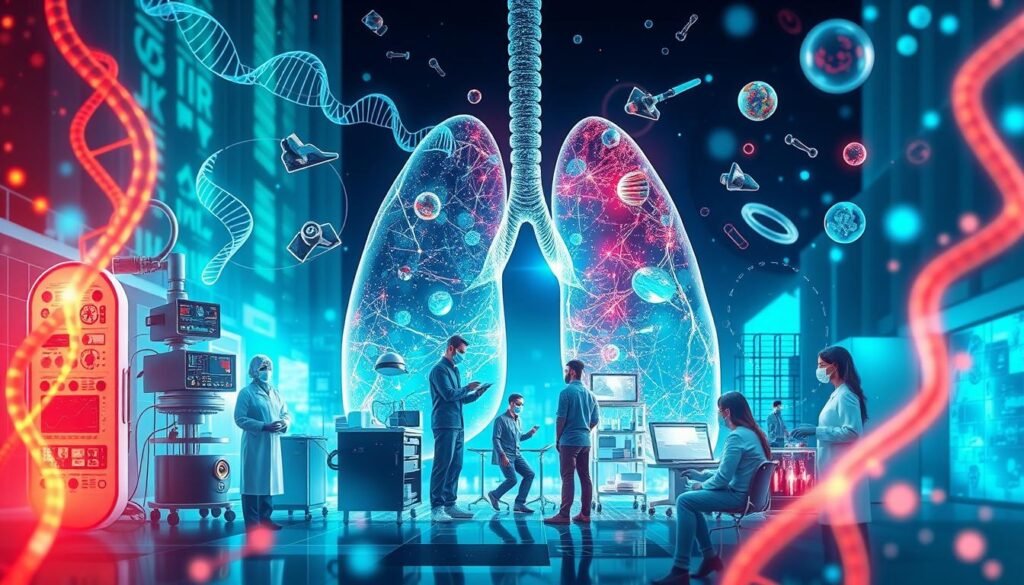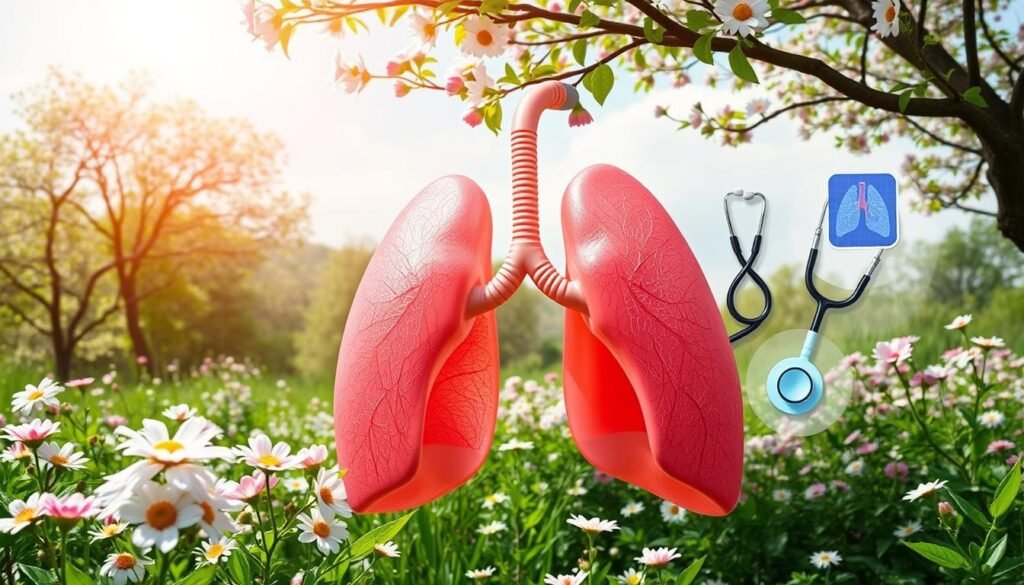Did you know only 28% of lung cancer patients survive five years after diagnosis? This fact brings up a big question: how curable is lung cancer? It also shows why finding cancer early and new treatments are important. Even though lung cancer used to hardly ever end well, things are changing. Now, there’s more hope for people who get this disease.
Success rates change depending on the cancer’s type and how soon it’s found. For example, if non-small cell lung cancer (NSCLC) is found early, the five-year survival rate can reach 65%. However, small cell lung cancer (SCLC) at the same stage has a 30% survival chance. These numbers tell us catching cancer early can make a big difference. Treatments are getting better too, with new surgeries, drugs, and therapies like immunotherapy giving patients more hope.
In this article, we’ll look closer at lung cancer. We’ll talk about its types, stages, and survival rates. Plus, we’ll cover the big progress being made in treatments. Understanding all this can help patients and their families through the tough times of a lung cancer journey.
Key Takeaways
- The overall five-year relative survival rate for lung cancer is 28%.
- Localized NSCLC has a survival rate of 65%, while localized SCLC has a 30% survival rate.
- Advancements in treatment options are improving outcomes for lung cancer patients.
- Early detection plays a vital role in the curability of lung cancer.
- Survival rates vary significantly by cancer type and stage at diagnosis.
- Emerging treatments like targeted therapy and immunotherapy are showing promising results.
Understanding Lung Cancer: An Overview
Lung cancer is the top cause of cancer deaths worldwide. It often starts due to many risk factors, with smoking being the biggest one. About 80% to 85% of lung cancers are Non-Small Cell Lung Cancer (NSCLC). Adenocarcinoma is the most common kind within this group. On the other hand, Small Cell Lung Cancer (SCLC) makes up about 10% to 15% of cases. SCLC grows and spreads faster than NSCLC.
Several factors like age, smoking history, and family background influence lung cancer risk. If you smoke a lot, your risk of getting lung cancer, especially SCLC, rises significantly. Being around secondhand smoke also increases your risk. Work-related exposures to harmful substances like asbestos and arsenic can up your risk too.
Having had radiation therapy to the chest before can make lung cancer more likely later on. Living healthy, including exercising, eating well, and steering clear of carcinogens, helps prevent it. You can learn more about risks from a lung cancer overview. It’s also critical to catch the disease early and treat it promptly.
It’s essential to know the different types of lung cancer to treat it effectively. NSCLC and SCLC need different treatments because they grow differently. Catching early signs is key to taking control quickly, especially for smokers or those with family histories of cancer. By understanding early warning signs, you’re better prepared. For info on early symptoms, check out early symptoms of lung cancer.
| Type of Lung Cancer | Prevalence | Growth Rate |
|---|---|---|
| Non-Small Cell Lung Cancer (NSCLC) | 80%-85% | Slower |
| Small Cell Lung Cancer (SCLC) | 10%-15% | Faster |
| Lung Carcinoid Tumors | Less than 5% | Very Slow |
Lung cancer’s varied types mean we must understand them to manage the disease better. Knowing these details is key for planning treatments and improving patient results.
Lung Cancer Types and Their Impact on Treatment
Knowing the types of lung cancer is key for choosing treatments. We have Non-Small Cell Lung Cancer (NSCLC) and Small Cell Lung Cancer (SCLC). Each has its own features and treatments, affecting how patients are cared for.
Non-Small Cell Lung Cancer (NSCLC)
NSCLC makes up about 80-85% of lung cancer cases. This group includes adenocarcinoma, squamous cell carcinoma, and large cell carcinoma. Adenocarcinoma, often found in non-smokers, starts in the lungs’ outer parts.
Squamous cell carcinoma grows in the central bronchi. Large cell carcinoma features big, fast-growing cells anywhere in the lungs. NSCLC treatments range from surgery to targeted therapy. Its slower spread means patients usually have more options.
Small Cell Lung Cancer (SCLC)
SCLC accounts for 15% of lung cancers, largely due to cigarette smoking. It grows and spreads faster than NSCLC. It has two main types: small cell carcinoma and combined small cell carcinoma. SCLC treatment often includes chemotherapy and radiation.
Because it grows quickly, catching it early is important for better outcomes. Studies on new treatments and combinations are ongoing for SCLC.
Lung Cancer Stages and Prognosis
Knowing about lung cancer stages is key in choosing treatments and predicting outcomes. Each stage is linked to different survival chances, influenced by factors like how far the cancer has spread. Getting to know these stages helps people know what to expect in their treatment journey.
Localized Stage
Lung cancer is only in the lungs at the localized stage. Here, the chance of living five years is about 64% for those with non-small cell lung cancer (NSCLC). Surgery, chemotherapy, and immunotherapy are common treatments. Finding the cancer early often means a better chance of survival than if found later. Making sure the cancer’s stage is correct helps doctors create the best treatment plan.
Regional Stage
When lung cancer spreads to nearby lymph nodes or tissues, it’s the regional stage. The chance of living five years goes down to roughly 37%. Treatments may include surgery, chemotherapy, and radiation. Even though spreading makes treatment harder, some patients may benefit from targeted therapies and immunotherapy.
Distant Stage
The distant stage means the cancer has spread to other body parts, lowering survival chances to about 8%. Treatments may be more extensive, including chemotherapy, radiation, immunotherapy, and targeted therapy. It’s crucial to understand how spreading affects treatment choices and outlook at this stage.
For more information on how lung cancer stages affect prognosis, see this resource. It offers insights for patients and their families facing this challenging diagnosis.
How Curable Is Lung Cancer?
Lung cancer curability mostly hinges on when it’s found. Finding it early makes a big difference in treatment success. When lung cancer is caught at Stage I, results look hopeful. Those with early lung cancer often see five-year survival rates over 65%. Some even reach 80% to 90% survival rates if treated quickly.
The most usual type, non-small-cell lung cancer (NSCLC), comes with many treatment choices that aid in curing it. Surgery often leads the way for early stages. Sometimes, doctors add chemotherapy or radiation to surgery depending on the cancer’s details. A new option, stereotactic body radiotherapy, works well for certain early-stage patients instead of surgery.
New treatments like immunotherapy and targeted therapies are changing the game. They specifically target genetic changes in the cancer. This is a big win for people with advanced cancer. Even if the cancer is found late, new studies and treatments keep bringing new hope.

Knowing the treatment options and the importance of early detection sheds light on lung cancer curability. With advances in medicine, there’s more hope for longer survival and better life quality for those fighting lung cancer.
Lung Cancer Survival Rates: What the Numbers Mean
Lung cancer survival rates vary a lot. They depend on the cancer type, stage when found, and patient health. These statistics help us understand what might happen after getting sick. They show trends but can’t predict exact outcomes for everyone.
Five-Year Relative Survival Rates
The five-year survival rate tells us how many patients live five years after finding out they have lung cancer. Sadly, this rate is low, under 20%. Yet, for localized non-small-cell lung cancer (NSCLC), the rate jumps to about 60%. But for stage IV cancers, making up 40% of cases, the rate drops to 5%.
Understanding Survival Rates by Stage
Survival rates change based on cancer stage. Look at this chart:
| Stage | Five-Year Survival Rate |
|---|---|
| Stage 1 | 65% |
| Stage 2 | 40% |
| Stage 3 | 15% |
| Stage 4 | 5% |
Finding cancer early improves survival rates. These stats are important but must be seen in context. The SEER database shows us how lung cancer treatments are getting better. To learn more, check out this source for extra info and details.
Advancements in Lung Cancer Treatment
Recent years have seen impressive progress in lung cancer treatment. New strategies aim to improve patient results significantly. We now have enhanced traditional treatments with targeted therapy and immunotherapy. These approaches lead to better results, even in late-stage cancer.
Targeted Therapy for Lung Cancer
Targeted therapy is changing how we fight lung cancer by zeroing in on specific genes that cause tumors. For example, Osimertinib (Tagrisso) is a new option for early-stage non-small cell lung cancer (NSCLC) patients. It works on certain EGFR gene mutations. The advent of Dabrafenib (Tafinlar) and Trametinib (Mekinist) for NSCLC with BRAF mutations is also a significant step forward.
Immunotherapy for Lung Cancer
Immunotherapy is a leading development in lung cancer care. It uses the body’s own immune system to fight cancer cells. Drugs like Atezolizumab (Tecentriq) and Pembrolizumab (Keytruda) are now approved for some early-stage NSCLC after surgery. Nivolumab (Opdivo), paired with chemo before surgery, also improves survival chances. These advances highlight how immunotherapy can significantly better surgical results.

A lot of lung cancer patients are found early when treatment hasn’t always worked well. Today, innovative therapies are creating new hope. A recent mix of chemo and immunotherapy has shown to be very promising. In 2024, the approval of Alectinib (Alecensa) marked a big success. It extended the time patients lived without their cancer returning compared to just chemo. Teams like those at the Sidney Kimmel Cancer Center play a crucial role. They help blend these advanced therapies into personalized treatment plans, improving patient care.
The Role of Clinical Trials in Lung Cancer Treatment
Clinical trials are key to improving lung cancer treatment. They help us find new ways to fight this disease. Every year, lots of people join these trials to test new treatments.
Clinical trials have different stages, each looking at a new treatment’s safety and effectiveness. Phase 1 trials test a few people to find the right dose and note any side effects. Phase 2 trials focus on seeing if the treatment works well enough to move to Phase 3.
Phase 3 trials compare new treatments to the ones we already have. This is how we find better ways to treat lung cancer. Imagine a patient in a trial seeing a 68% improvement in their condition. That’s huge!
Patients in trials get checked on more than usual. This means more tests and visits to doctors, but it helps get the best results. Whether you can join a trial depends on things like your health and past treatments.
The info from these trials can make treatments better and even get new ones approved. If you or someone you know has lung cancer, looking into trials might be a good move. You can learn more from healthcare providers or by visiting understanding the benefits of clinical trials for cancer.
| Phase | Purpose | Focus |
|---|---|---|
| Phase 1 | Determine dosage and side effects | Small group of participants |
| Phase 2 | Assess treatment effectiveness | Evaluate potential for Phase 3 |
| Phase 3 | Compare new treatments to standard therapies | Determine overall efficacy |
Lung Cancer Prevention and Early Detection
Lung cancer is the second most common cancer in the United States. It’s also the top cause of cancer-related deaths. To prevent it, focus on quitting smoking and living healthier. About 90% of lung cancer cases are due to smoking.
It’s vital to detect lung cancer early to fight it effectively. Traditional chest X-rays don’t work well for screening. Instead, Low-dose computed tomography (LDCT) scans are better. They detect cancer early. The American Cancer Society suggests yearly LDCT scans for 50- to 80-year-olds with a heavy smoking history.

Yet, only 21% of lung cancers are found when still localized. High-risk groups are current and recent smokers, and those 55 to 80 years old. Early screening lowers death rates and improves life quality for lung cancer patients.
Working together, healthcare providers and patients can make good decisions about screening. Understanding the pros and cons leads to better choices. For more on LDCT screening, visit here.
| Screening Method | Effectiveness | Radiation Exposure | Applicable Age Group |
|---|---|---|---|
| Chest X-ray | Less effective for early detection | Low | All ages |
| Low-Dose CT Scan | Proven to save lives | Moderate | 50 to 80 years |
The Importance of Early Diagnosis
Finding lung cancer early is key to better treatment results. Statistics show that early detection greatly increases survival chances. In fact, 65% of people survive more than five years if found early. Sadly, only 26.6% of lung cancer is caught at this stage. This highlights the need for more awareness and better screening.
Statistics on Early Diagnosis
Lung cancer is a major health issue around the world. Each year, 8.8 million people die from cancer, with most deaths in poorer countries. Over 14 million new cancer cases are reported every year. This number is expected to exceed 21 million by 2030. Unfortunately, early diagnosis is especially hard in low-income countries, where only 30% have access to cancer care services.
- About 546,890 more people were screened for cancer from March 2021 to October 2022. This shows a move towards early detection.
- The NHS aims to detect 75% of cancers at an early stage by 2028. This goal supports lung cancer early diagnosis efforts.
- Programs like the targeted lung health check have found over 1,500 lung cancers early. A whopping 76% of these were early stages.
Impact of Early Treatment on Survival Rates
Early treatment is crucial for boosting survival rates. It also makes economic sense, as it significantly lowers treatment costs. Treating cancer in its early stages can be two to four times cheaper than treating it later. Early treatment strategies can save a lot of money and improve patient outcomes in wealthier countries.
Raising awareness about lung cancer signs and symptoms is very important. Catching cancer early not only improves survival rates but also reduces the cost of treating advanced cancer. Education and new programs are key to better outcomes in the fight against lung cancer.
Conclusion
Lung cancer is a complex disease, but there’s hope for those diagnosed. While only 20% survive longer than five years, treatments are getting better. Targeted therapies like osimertinib are making a big difference for certain patients. It’s key to understand the types of lung cancer to find the best treatment.
Finding lung cancer early can save lives. Even though screenings can cut death rates by 20%, few people get tested. A push in 2021 to get more people screened is underway. This effort can help more people beat lung cancer.
New research is opening doors to better treatments. Techniques like cell-free DNA analysis are personalizing care. This leads to hope for better outcomes. Staying up-to-date with health care gives people fighting lung cancer a strong chance.